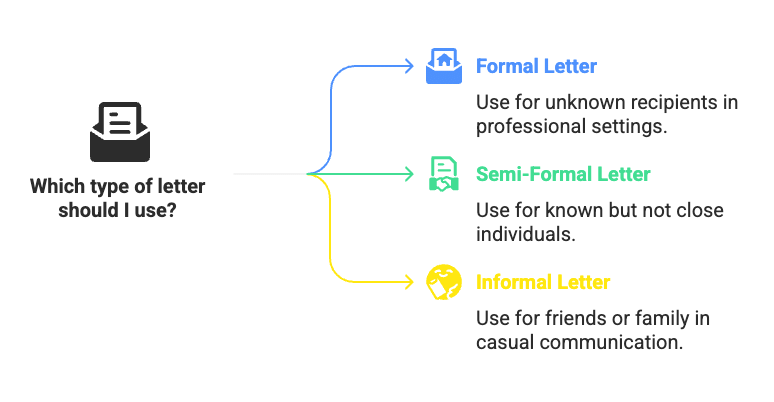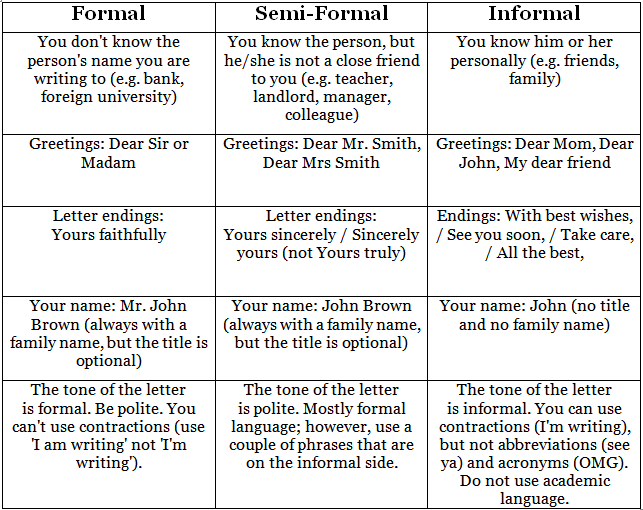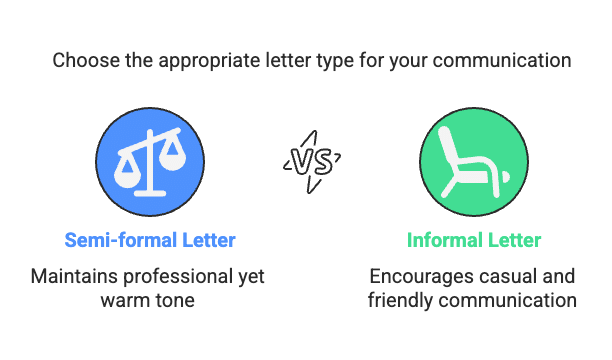IELTS General Writing Task 1: Types of Letters | Writing for General Training IELTS PDF Download
| Table of contents |

|
| Differences: Formal, Semi-Formal and Informal |

|
| Formal Letter |

|
| Semi-formal Letter |

|
| Informal/Personal Letter |

|
In IELTS General Writing Task 1, you write a letter — and it has to fit the situation. There are three types: formal, semi-formal, and informal (also called personal). Picking the wrong one messes up your score, so here’s how to choose, set the right tone, and start and end it properly. We’ll show you the differences, give examples, and help you get it right.
The Three Types
- Formal Letter: For people you don’t know at companies—like a bank or school.
- Semi-Formal Letter: For someone you know by name but aren’t close to—like a teacher or neighbor.
- Informal Letter: For friends or family—think casual notes.
You need to figure out which one before you write. It changes how polite or friendly you sound and how you open and close.

Differences: Formal, Semi-Formal and Informal
To outline the main differences between formal, semi-formal and informal letters and also help you decide which letter style you should use, see the following table:
Simple questions which help you understand what kind of letter it is:
- Who’s Getting It? A company you don’t know = formal. A named person you’re not pals with = semi-formal. A buddy = informal.
- What’s It About? Big deals (e.g., job apps) = formal. Work or neighbor stuff (e.g., fixing something) = semi-formal. Personal talk (e.g., “Miss you!”) = informal.
Formal Letter
Purpose: This type is used when addressing an organization or an unknown individual, such as when requesting information from an educational institution or lodging a complaint with a retailer.
Tone: Courteous and direct, avoiding informal expressions or humor.
Opening: "Dear Sir or Madam,"
Closing: "Yours faithfully/sincerely"
Example:
“Dear Sir or Madam,
I am writing regarding a defective mobile phone purchased from your store on May 5th. It has ceased to function. I request either a repair or a refund at your earliest convenience. I await your prompt response. ”
Common Uses: Complaints, applications, arrangements, or inquiries.
Semi-formal Letter
Purpose: This type is appropriate when addressing an individual known by name, with whom you share a professional or business-like relationship, such as a teacher, landlord, or colleague, but not a close personal connection.
Tone: Polite and approachable, striking a balance between formality and warmth, without excessive familiarity.
Opening: "Dear [Title + Surname], e.g., Dear Mr. Thompson,"
Closing: "Yours sincerely"
Example:
“Dear Ms. Carter, I am your tenant at 12 Oak Street and am writing to report an issue with the heating system, which has malfunctioned again. I would appreciate it if you could arrange for a repair by this Friday. Thank you for your attention to this matter.”
Common Uses: Invitations, requests for assistance, explanations, or updates related to professional or practical matters.

Informal/Personal Letter
Purpose: This type is employed when addressing a friend, family member, or individual with whom you share a close personal relationship, typically concerning everyday or personal matters.
Tone: Relaxed and conversational, reflecting warmth and familiarity suitable for informal interactions.
Opening: "Dear [First Name], e.g., Dear Sarah,"
Closing: "Best regards," or "Warm wishes,"
Example:
“Dear Tom, I hope you’re doing well. I’m hosting a small gathering at my place next Saturday and would love for you to join us if you’re available. It’s been a while since we caught up, and I’d really enjoy seeing you there.”
Common Uses: Invitations, personal updates, apologies, or expressions of gratitude in a casual context.
|
33 videos|170 docs
|
FAQs on IELTS General Writing Task 1: Types of Letters - Writing for General Training IELTS
| 1. What are the different types of letters in the IELTS General Writing Task 1? |  |
| 2. What is the purpose of writing a formal letter in the IELTS General Writing Task 1? |  |
| 3. How is a semi-formal letter different from a formal letter in the IELTS General Writing Task 1? |  |
| 4. What is the purpose of writing an informal letter in the IELTS General Writing Task 1? |  |
| 5. How important is it to follow the specific format and language style for each type of letter in the IELTS General Writing Task 1? |  |




















